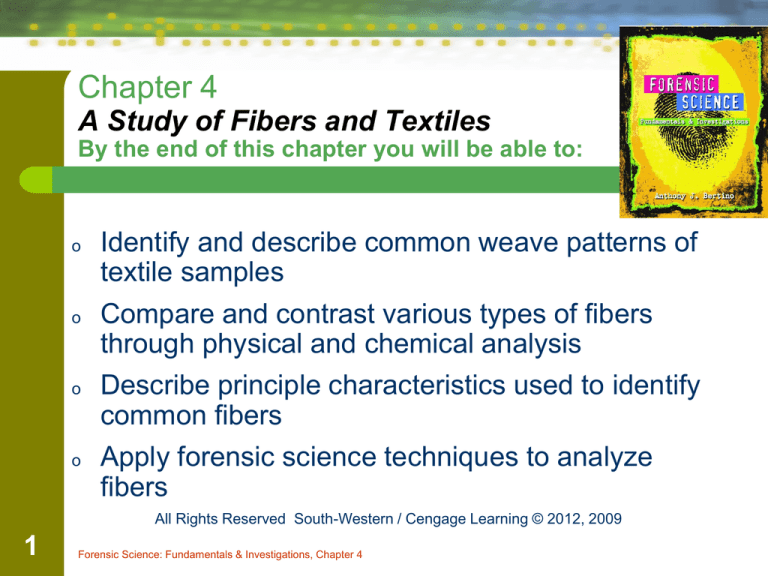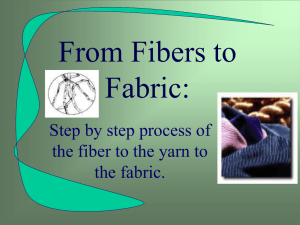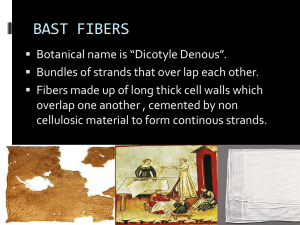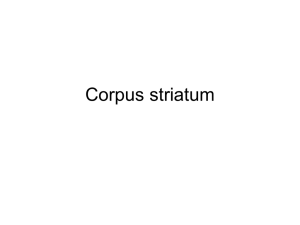
Chapter 4
A Study of Fibers and Textiles
By the end of this chapter you will be able to:
o
o
o
o
Identify and describe common weave patterns of
textile samples
Compare and contrast various types of fibers
through physical and chemical analysis
Describe principle characteristics used to identify
common fibers
Apply forensic science techniques to analyze
fibers
All Rights Reserved South-Western / Cengage Learning © 2012, 2009
1
Forensic Science: Fundamentals & Investigations, Chapter 4
Introduction
o
o
Fibers are used in forensic science to create a link
between crime and suspect
Through normal activities
–
–
o
o
2
We shed fibers
We picked up fibers
Very small fibers are classified as trace evidence
Collecting fibers within 24 hours is critical
Forensic Science: Fundamentals & Investigations, Chapter 4
How Forensic Scientists
Use Fibers
Fiber evaluation can show
•
•
•
•
•
3
Type of fiber
Color
Possibility of violence
Location of suspects
Point of origin
Forensic Science: Fundamentals & Investigations, Chapter 4
Sampling and Testing
o
o
o
o
Shedding—common form of fiber transfer
Microscopes reveal characteristic shapes
and markings
Infrared spectroscopy reveals chemical
structures to differentiate similar fibers
Destructive Testing Methods
•
•
4
Burning fibers
Dissolving fibers in various liquids
Forensic Science: Fundamentals & Investigations, Chapter 4
Sampling and Testing
Compare fibers found on different suspects with those
found at the crime scene
5
Forensic Science: Fundamentals & Investigations, Chapter 4
Fiber Classification
—Natural Fibers
Animal fibers (made of proteins):
o
Wool and cashmere from sheep
o
Mohair from goats
o
Angora from rabbits
o
Hair from alpacas, llamas, and
camels
o
Silk from caterpillar cocoons
(longer fiber does not shed easily)
6
Forensic Science: Fundamentals & Investigations, Chapter 4
woven
wool
textile
Fiber Classification
—Natural Fibers
Plant fibers (made of the polymer cellulose):
o Absorb water
o Insoluble in water
o Very resistant to damage from harsh
chemicals
o Dissolvable only by strong acids
o Becomes brittle over time
7
Forensic Science: Fundamentals & Investigations, Chapter 4
Fiber Classification
—Natural Fibers
Plant fibers:
o
Cotton—most common textile
plant fiber (picture)
o
Coir from coconuts is durable
o
Hemp, jute, and flax from stems grow in
bundles
o
Manila and sisal from leaves deteriorate
more quickly
8
Forensic Science: Fundamentals & Investigations, Chapter 4
Fiber Classification
—Natural Fibers
Mineral Fibers:
o
o
9
Fiberglass—a fibrous form of glass
Asbestos—a crystalline structure
Forensic Science: Fundamentals & Investigations, Chapter 4
Fiber Classification
—Synthetic Fibers
o
o
50% of fabrics are artificially produced
Examples:
•
•
•
•
•
10
Rayon
Acetate
Nylon
Acrylic
Polyester
Forensic Science: Fundamentals & Investigations, Chapter 4
Fiber Classification
—Synthetic Cellulose Fibers
Regenerated Fibers (derived from cellulose):
o
Rayon
–
–
o
Celenese®
–
–
o
Cellulose chemically combined with acetate
Found in many carpets
Polyamide nylon
–
–
–
11
Most common in this group
Imitates natural fibers, but stronger
Cellulose combined with three acetate units
Breathable and lightweight
Used in performance clothing
Forensic Science: Fundamentals & Investigations, Chapter 4
Fiber Classification
—Synthetic Polymer Fibers
Synthetic Polymer Fibers
o
Petroleum base
o
Very different from other fibers
o
Monomers join to form polymers
o
Fibers are spun together into yarns
o
No internal structures
o
Uniform diameters
12
Forensic Science: Fundamentals & Investigations, Chapter 4
Fiber Classification
—Synthetic Polymer Fibers
o
Polyester
•
•
•
•
o
“Polar fleece”
spandex nylon
Wrinkle-resistant
Not easily broken down by light or concentrated acid
Added to natural fibers for strength
Nylon
• Easily broken down by light and concentrated acid
• Otherwise similar to polyester
13
Forensic Science: Fundamentals & Investigations, Chapter 4
Fiber Classification
—Synthetic Polymer Fibers
o
Acrylic
• Inexpensive
• Tends to “ball” easily
• Substitute for artificial wool or fur
o
Olefins
• High performance
• Quick drying
• Resistant to wear
14
Forensic Science: Fundamentals & Investigations, Chapter 4
Comparison of Natural and
Synthetic Fibers
Visual Diagnostics of Some Common Textile Fibers
under Magnification
15
Forensic Science: Fundamentals & Investigations, Chapter 4
Yarns, fabrics, and textiles
o
o
o
Yarns—fibers (of any length, thick or thin,
loose or tight) twisted or spun together
Blending fibers meets different needs
(e.g., resistance to wrinkling)
Fibers are woven into fabrics or textiles
•
•
16
Threads are arranged side by side (the warp)
More threads (the weft) are woven back and forth
crosswise through the warp
Forensic Science: Fundamentals & Investigations, Chapter 4
Weave Patterns
17
Forensic Science: Fundamentals & Investigations, Chapter 4
. . . . . . . . . . . . . Summary . . . .
o
o
o
o
o
18
Fibers are a form of class evidence.
Fibers are a form of trace evidence.
Fibers are spun into yarns having specific
characteristics.
Yarns are woven, with different patterns, into
clothing or textiles.
Fiber evidence is gathered using different
techniques.
Forensic Science: Fundamentals & Investigations, Chapter 4
. . . . . . . . . . . . . . . . . Summary
o
o
o
Fibers are analyzed using burn tests, tests for
solubility in different solutions, polarized light
microscopy, or infrared spectroscopy.
Fibers are classified as natural or synthetic.
Natural fiber sources include:
• Animal hair
• Plant seeds, fruit, stems, or leaves
• Minerals.
19
Forensic Science: Fundamentals & Investigations, Chapter 4









